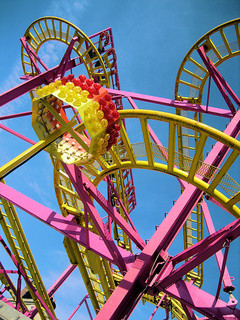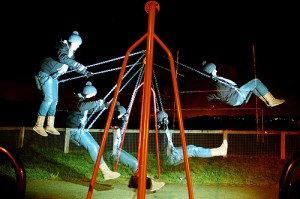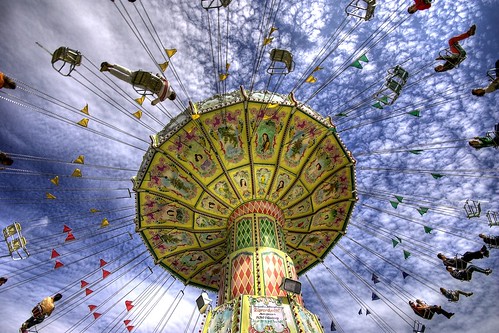A friend recently took his kids on a much-anticipated trip to Disneyland. When I saw him afterward and asked how it was, he shook his head. “We went on Space Mountain,” he said, by way of explanation.
He has two kids under six, so I figured they’d gotten scared. Later, my husband told me what really happened: the kids had loved it. Our friend had nearly puked.
My own parents would never have taken me on a roller coaster, although my dad did chaperone the Milli Vanilli/Paula Abdul concert at an amusement park, which probably required a stronger stomach than any ten-story drop. I’ve been on a few big rides (my glory day was a high school physics field trip to Great America, when I rode the Demon, Top Gun, and the Vortex in exchange for filling out a worksheet on momentum and acceleration) but never really caught the coaster bug.
Still, I felt for my friend. In the last few years, I’ve started to feel a bit queasy on the most benign of rides, just as my son is starting to enjoy the giddiness of dizzying pastimes.
 When I started to look into whether motion sickness might be increasing with age, what I found was a little unsettling–in that there’s still very little known about why we have it and how it works.
When I started to look into whether motion sickness might be increasing with age, what I found was a little unsettling–in that there’s still very little known about why we have it and how it works.
There are a few different categories of motion sickness, but in general, it’s thought that motion sickness comes from when what a person sees doesn’t match up with the motion the body feels.
Women tend to be more affected by motion than men, particularly during their menstrual cycles. Migraine sufferers are at-risk for motion sickness, too—and women who haven’t been struck by motion sickness in the past can become more likely to get it around the two peak migraine onset periods (around age 35 and again at menopause). There may also be a genetic component to motion sickness.
Much of the motion-sickness literature reports that babies and toddlers under two are seldom victims. One thought as to why we get motion sickness is that it’s designed to stop movement that makes us unstable or involves conflict between different senses, and that avoiding this kind of movement would confer evolutionary fitness. In Brain Research Bulletin, Brad Bowins goes on to propose that motion sickness’s negative reinforcement would only work once a person could act to relieve its effects, eliminating its “advantage” in those too young to physically respond.
What throws me off is that motion sickness is actually more common in children (ages 2 to 12) than in adults. I still haven’t been able to find much about why kids are more prone to motion sickness, but also usually seem to love twirling, spinning, and tumbling so much.
 Adults might be getting less fond of whirling because we’ve had more time to racking up a long list of things that make motion sickness worse, from illness to lifestyle. Colds, sinus infections and other ailments can tinker with your inner ear (home of the vestibular system, which helps the body sense movement and position). Booze, dehydration, too much or too little food can also increase the likelihood of getting sick. Suddenly, I’m remembering the ice cream and half-bottle of wine I had before co-piloting a tiny airplane at Tivoli Gardens—bleh.
Adults might be getting less fond of whirling because we’ve had more time to racking up a long list of things that make motion sickness worse, from illness to lifestyle. Colds, sinus infections and other ailments can tinker with your inner ear (home of the vestibular system, which helps the body sense movement and position). Booze, dehydration, too much or too little food can also increase the likelihood of getting sick. Suddenly, I’m remembering the ice cream and half-bottle of wine I had before co-piloting a tiny airplane at Tivoli Gardens—bleh.
Some adults are thrown for another loop by Ménière’s disease, a disorder that affects the inner ear and brings with it a symptom roulette that can include sudden, severe vertigo. Astronaut Alan Shepard spent six years grounded by Ménière’s after his first NASA mission. After successful corrective surgery, Shepard went on to command the Apollo 14 mission at 47, becoming the fifth person to walk on the moon.
To learn more about plain-old motion sickness (and how astronauts and pilots can minimize its effects), researchers from NASA and the U.S. Navy send people spinning around on quease-inducing chairs. They’re looking at medications that might help, as well as techniques like biofeedback and adaptation to motion through repeated exposure.
I’m not sure I’ll go so far as to take medication for the roller coasters—as one amusement park sales and marketing director does–or ride so many that I’ll feel acclimated. But if my son wants me to ride the Demon with him, I’ll give it a whirl. And I promise I’ll sit through any cheesy, possibly-lip-synched pop concerts—and embarrass my kids by being the crazy lady who’s still spinning.
**
Images Top: Toni V Middle: Stéfan Bottom: Mike Leary

A story that would fit with that involves a kind of non-motion sickness. In the 1970s British Railways trialled a new super-fast train called the Advanced Passenger Train. Getting anything to go super-fast on the British network without incredible rebuilding meant that it had to use existing tracks, so they looked at tilting-body vehicles so as to be able to take corners faster. By the time they rolled the second APT (there had been an earlier one to test whether electricity or gas turbines made more sense for power plant) out they were pretty good at this; the train was so perfectly calibrated that drinks stayed level and test passengers never knew they’d tilted till they looked out of the window, at which point many of them felt sick. The conclusion, not scientific but pragmatic, was that passengers needed to know when the train was going over, somehow, even though the idea was offputting, and this was one of a whole string of reasons the project stopped there and the old train is now mouldering at Crewe. (An undergraduate dissertation I just Googled up contains citations and sources.)
Ooh, great topic! That motion sickness is more common in women and migraine sufferers (two categories to which I belong) makes my own proclivity feel somehow validated.
When I was researching seasickness, I found an iconoclast named Stoffregen who theorizes that it’s caused by postural instability rather than sensory conflict. An interesting idea!
There was something I read on another website about how motion sickness is actually due to not having strong core muscles. So essentially, a child or exercise lacking adult would have weak stomach muscles and thus unable to stop their stomachs from tossing.
I actually tested this myself. When I rode the ferry as a child I would get sea-sick (even now I get carsick), but the last time I went on the ferry I held in my stomach muscles and did not get sick.
@Jonathan Thank you so much for the story, and the link–I’m sorry that queasiness was one of the reasons for the train’s demise.
@Danna Yes!! I’d seen that SciAm story, but forgot to include it, so thank you for doing so. And I’m sorry about your kharouping incident (though glad to have a new word).
@Magoonski Fascinating! I’ll try it on my next rollercoaster ride, if I’m not too busy screaming. (And I’ll look around for the reference–thanks!)
Back in the day, I coached our teenaged sons’ soccer team. I chaperoned the team on a trip to Great America where a group of the players challenged me to ride the roller coasters. A challenge made was a challenge accepted with the result that, by the end of the day. I rode the various roller coasters 21 times. I have no idea what this article is about.
Oh man. The stupid age thing (and perhaps menopause thing). I felt slightly seasick on the ferry this year — no rough seas or anything and the very same ride we take every summer to and from the beach. Me, who never gets carsick or seasick or planesick. Yuck.
@Old Geezer, I bow to your stomach of steel.
Another data point on being sick amping up the motion sickness – I got mono at college, as one does. I hadn’t ever been motion sick before that, but while I had it, even reading made me ill. I’ve had motion sickness ever since. It’s pretty annoying.
It’s also kind of weird because I didn’t grow up with it so I can be on a boat, enjoying the rocking motion and thinking, “hey, why am I sick?” whereas people who grow up motion sick just associate the rocking with being ill. I have trouble taking a boat out to dive or snorkeling, but am a-ok under the water with a scuba tank. I made it through a roller coaster on my belly until the 2nd rough brake, at which point red popsicle remains went everywhere and I spent the three subsequent days feeling ill, so now I take meds.
I take scopalomine for motion sickness (either a pill for short duration or the patch for longer stints) and it works fantastically well. It’s not perfectly side-effect free Thanks to the interwebs I recently found out that it can also be misused in large doses to induce memory loss, and I know that if I use the patches continuously for more than a couple days, my eyes start to have trouble focusing, and most people get some dry mouth. On the plus side, I don’t get hungry when I take it, it doesn’t change my alertness, and I don’t barf. So I do recommend trying it to see if you can tolerate the side effects because it works great.